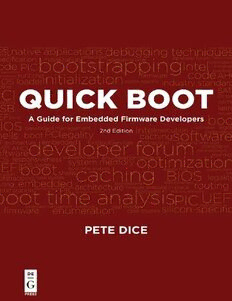
Quick Boot: A Guide for Embedded Firmware Developers PDF
Preview Quick Boot: A Guide for Embedded Firmware Developers
Pete Dice Quick Boot ISBN 978-1-5015-1538-5 e-ISBN (PDF) 978-1-5015-0681-9 e-ISBN (EPUB) 978-1-5015-0672-7 Library of Congress Cataloging-in-Publication Data A CIP catalog record for this book has been applied for at the Library of Congress. Bibliographic information published by the Deutsche Nationalbibliothek The Deutsche Nationalbibliothek lists this publication in the Deutsche Nationalbibliografie; detailed bibliographic data are available on the Internet at http://dnb.dnb.de. © 2018 Pete Dice Published by Walter de Gruyter Inc., Boston/Berlin www.degruyter.com Acknowledgments The studies, data, results, and guidelines compiled in the book are the result of many talented engineers at Intel who have a strong passion for BIOS and firmware. The contributions they have made and the time they have spent, much of it outside their normal duties, deserve to be acknowledged. For significant contributions to this book for analyses, cases studies, and written content, I’d like to thank these talented engineers: –Jim Pelner—who crafted the original white paper that echoes the main themes of this book and for contributing to several chapters early on. –Jaben Carsey—who wrote the shell chapter in the book above and beyond his many contributions to the UEFI shells in general. –Sam Fleming—who created Appendix A and has been one of my mentors in BIOS from the beginning. –Mike Rothman, Anton Cheng, Linda Weyhing, Rob Gough, Siddharth Shah, and Chee Keong Sim—for their exquisite multiyear collaboration around the fast boot concept and multiple case studies over the year. –BIOS vendor Insyde Software for donating feedback and volunteering for the foreword. Thanks to my program manager, Stuart Douglas, for getting me through the writing phase and then on to the finish line (are we there yet?). Reviewer comments and suggestions were extremely valuable for both editions of this work. I deeply appreciate those who took the time to provide indispensable feedback, including Drew Jensen, Mark Doran, Jeff Griffen, John Mitkowski, and Dong Wei and at my publisher, Jeff Pepper, Megan Lester, Mark Watanabe and Angie MacAllister for her work on fixing the art and tables. I would also like to acknowledge my peers in the BIOS/FW engineering and architecture teams within the computer industry for their drive to make this technology an ever more valuable (and less obtrusive) part of people’s everyday lives. Lastly, I want to thank my wife, Anita, for her patience and everything she’s done to allow me time to complete this. Contents Chapter 1: System Firmware’s Missing Link Start by Gathering Data Initialization Roles and Responsibilities System Firmware OS Loader Operating System Legacy BIOS Interface, UEFI, and the Conversion Tiano Benefits Previous UEFI Challenges Persistence of Change The Next Generation Commercial BIOS Business Award General Software Phoenix Technologies Limited American Megatrends Inc. Insyde Software ByoSoft Value of BIOS Proprietary Solutions Making a Decision on Boot Firmware Consider Using a BIOS Vendor Consider Open-Source Alternatives Consider Creating Something from Scratch Consider a Native Boot Loader for Intel ® Architecture Just Add Silicon Initialization Summary Chapter 2: Intel Architecture Basics The Big Blocks of Intel Architecture The CPU The Front Side Bus The North Bridge, PCIset, AGPset, MCH, Uncore, System Agent The Transparent Link (Hublink, DMI, ESI) The South Bridge, Also Known as the PIIX, I/O Controller Hub (ICH), I/O Hub (IOH), Enterprise South Bridge (ESB), and Platform Controller Hub (PCH) Data Movement Is Fundamental It’s a Multiprocessing System Architecture The Memory Map I/O Address Range The Operating System Summary Chapter 3: System Firmware Terms and Concepts Typical PC/Intel® Architecture Overview Memory Types Processor Cache System Memory Complementary Metal-Oxide Semiconductor (CMOS) System BIOS Flash Memory (NVRAM, FWH, or SPI) Real-Time Clock (RTC) System Memory Map Legacy Address Range Main Memory Address Range PCI Memory Address Range Splash Screen Status and Error Messages Display Messages Beep Codes POST Codes Master Boot Record GUID Partition Table Real Mode Protected Mode
